Your VR headset needs specific video formats because it splits content between two displays positioned extremely close to your eyes, requiring much higher pixel density than traditional screens. Standard videos appear pixelated and blurry in VR due to the proximity effect, while stereoscopic formats deliver separate images to each eye for proper depth perception. VR headsets also demand specialized codecs like H265 and resolutions up to 3840×3840 pixels per eye. Understanding these technical requirements will help you choose the right content for peak visual quality.
Understanding VR Display Technology and Pixel Density Requirements
When you strap on a VR headset, you’re placing displays just inches from your eyes, which fundamentally changes how video content must be formatted and refined.
Unlike traditional screens where you sit several feet away, VR technology puts pixels directly in your field of view, making every detail magnified and scrutinized.
Your VR headset demands considerably higher pixel density to deliver a convincing immersive experience. Devices like the Meta Quest 2 require around 20 pixels per degree for peak clarity.
This technical requirement means standard video formats that work perfectly on your TV or computer monitor won’t cut it in virtual reality.
The proximity effect fundamentally creates a “zoom in” scenario where inadequate video quality becomes glaringly obvious, revealing pixelation and blurriness that would otherwise go unnoticed on conventional displays.
Monoscopic 360 Video Format Fundamentals
Understanding these technical demands leads us to examine the specific video formats that work within VR’s constraints.
The monoscopic format serves as the foundation for immersive video, delivering content through a single channel to both eyes using typical 2:1 aspect ratios like 3840×1920. You’ll notice this creates a flatter experience since the effective resolution drops considerably when distributed across your field of view.
The monoscopic format excels in chaotic environments where stitching anomalies could disrupt the experience, making it perfect for live events and journalism.
Without dual video channels, you’ll benefit from reduced file sizes and efficient bandwidth usage, though you’ll sacrifice the depth perception that stereoscopic alternatives provide.
Stereoscopic 3D 360 Video for Enhanced Depth Perception
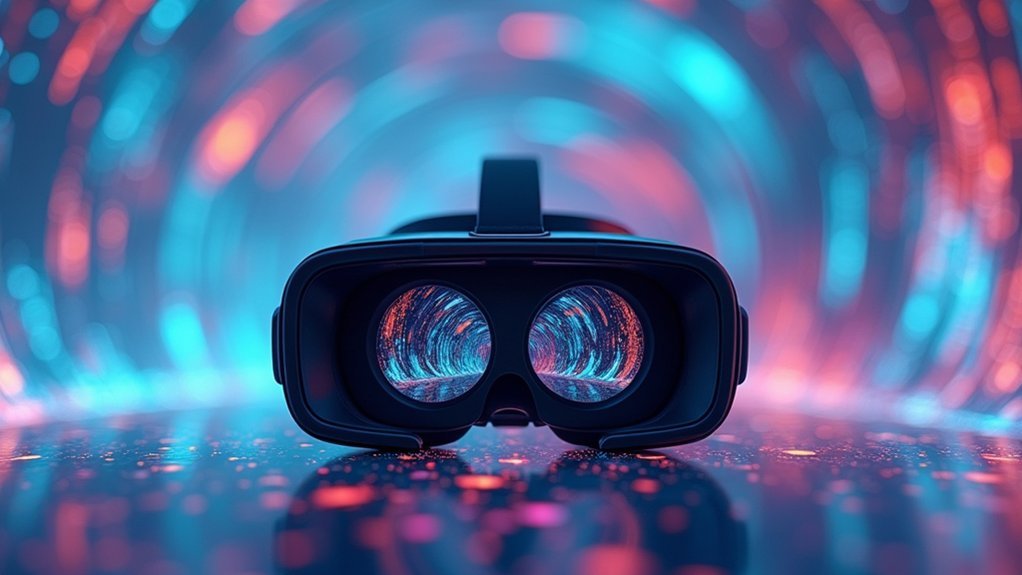
When you’re ready to experience true depth in VR, you’ll need to understand how stereoscopic 3D 360 video uses dual channel technology to deliver separate images to each eye.
You’ll require specialized camera setups that can capture two synchronized perspectives simultaneously, which greatly impacts your equipment choices and budget.
You’ll also need to plan for double the resolution output since each eye receives half the total image data, directly affecting your final video quality.
Dual Channel Technology
As VR technology advances beyond simple panoramic viewing, dual channel technology emerges as a game-changer that delivers true stereoscopic 3D 360 video experiences. You’ll discover that this system feeds separate video streams to each eye, creating convincing depth perception that transforms your immersive experience.
| Technical Aspect | Dual Channel Requirement |
|---|---|
| Resolution | Double standard resolution |
| Camera Setup | Specialized cameras for simultaneous capture |
| Display Format | Side-by-side or top/bottom configuration |
| Viewing Equipment | VR headsets or 3D glasses required |
When you’re producing stereoscopic 3D content, you’ll need precise camera positioning to prevent eye strain. The dual channel technology fundamentally halves each eye’s effective resolution, demanding higher source resolutions. You can’t experience this depth effect on standard displays—only proper VR headsets reveal the technology’s full potential.
Camera Requirements Considerations
The complexity of dual channel technology directly impacts your camera selection and setup requirements for stereoscopic 3D 360 video production.
You’ll need specialized cameras that’re considerably more expensive than standard 360 equipment, creating substantial budget considerations. These camera requirements demand precise positioning and calibration to prevent viewer discomfort.
Unlike monoscopic formats, you must shoot at double the resolution since stereoscopic 3D effectively halves your final output quality. Common resolutions include 3840×3840, 5120×5120, and 7680×7680 to maintain adequate detail for VR headsets.
Proper camera setup prevents stitching anomalies and visual distortions that cause eye strain.
Poor calibration creates viewing discomfort that’ll ruin your immersive experience. You can’t afford to compromise on camera quality or setup precision when producing stereoscopic content.
Resolution Quality Impact
Resolution demands skyrocket when you’re working with stereoscopic 3D 360 video, fundamentally changing how you approach quality standards. You’ll need double the resolution of monoscopic video formats since each eye requires its dedicated channel. This resolution quality impact directly affects your immersive experience – what starts as 5120×5120 becomes effectively 2560×2560 per eye.
| Resolution | Pixels Per Degree | Quality Rating |
|---|---|---|
| 3840×3840 | 12-15 PPD | Good |
| 5120×5120 | 15-18 PPD | Better |
| 7680×7680 | 20-25 PPD | Excellent |
| 8192×8192 | 25-30 PPD | Premium |
| 10240×10240 | 30+ PPD | Professional |
Higher pixels per degree reduce pixelation and enhance depth perception. Stereoscopic 3D demands these elevated standards to deliver convincing three-dimensional visuals that don’t strain your eyes during extended viewing sessions.
VR180 Format: Balancing Immersion and Practicality
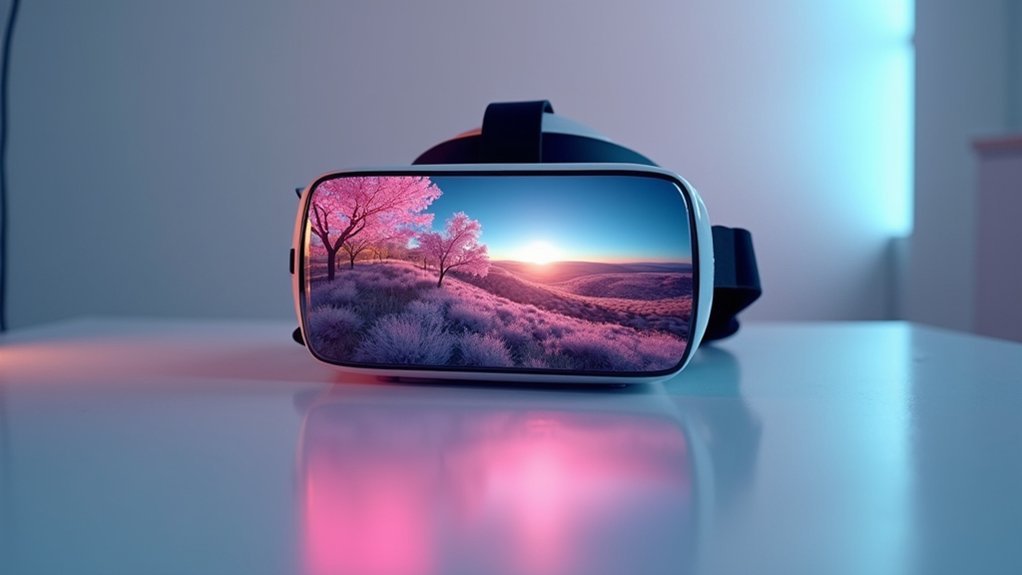
When you need immersive content that won’t break your budget or overwhelm your hardware, VR180 format offers an elegant compromise. This format uses two video channels to capture a front-facing 180-degree field of view, delivering a compelling sense of presence while maintaining practical production requirements.
You’ll find VR180 cameras resemble traditional 3D film setups with dual wide-angle lenses, making them accessible for creators shifting from conventional filmmaking. The format reduces processing demands and file sizes considerably compared to full 360-degree video, yet still allows natural head movement during viewing.
While VR180 provides less immersive experience than complete spherical video, it’s perfectly suited for narrative storytelling and applications where rear viewing isn’t necessary. This balance makes it increasingly popular across entertainment sectors.
Resolution Challenges in Virtual Reality Environments
You’ll face significant hurdles when trying to achieve ideal resolution in VR environments, starting with how pixel density gets distributed unevenly across your field of view.
Your headset’s processing power becomes a bottleneck when handling the massive computational demands of high-resolution content, especially when rendering for both eyes simultaneously.
These limitations force you to make tough trade-offs between visual fidelity and smooth performance, particularly when your field of view expands beyond what traditional displays can efficiently handle.
Pixel Density Distribution
Twenty pixels per degree represents the minimum threshold your VR headset needs to deliver clear visuals, but achieving this standard creates significant technical hurdles that didn’t exist with traditional displays.
Your pixel density requirements for VR content far exceed conventional video because you’re viewing screens mere inches from your eyes. When you’re creating monoscopic content, you’ll need at least 3840 x 1920 pixel resolution, while stereoscopic experiences demand 3840 x 3840 pixels per eye.
This massive resolution requirement strains encoding capabilities and file sizes dramatically. You can’t simply upscale traditional video formats because they weren’t designed for such close viewing distances.
The result is that your immersive experience depends entirely on distributing these dense pixels efficiently across your field of view.
Field of View Limitations
Your VR headset’s field of view creates a resolution paradox that compounds the pixel density challenge. While traditional displays spread pixels across a wide viewing angle, VR’s limited field of view concentrates your vision into a smaller area, demanding higher resolution to maintain visual clarity.
You’re fundamentally viewing content through a magnifying glass, where every pixel becomes more noticeable. This limitation forces VR systems to achieve around 20 pixels per degree to deliver acceptable image quality.
When you’re consuming stereoscopic content, the challenge intensifies since each eye receives half the total resolution. Your VR experience suffers dramatically if content isn’t optimized for these constraints.
That’s why VR-specific video formats must account for both the concentrated viewing area and the increased pixel density requirements inherent to immersive environments.
Processing Power Constraints
While VR headsets demand exceptional visual fidelity, they’re constrained by the processing limitations of their hardware platforms.
The intensive computational requirements for rendering high-resolution VR content create significant bottlenecks that affect your viewing experience.
Processing power directly impacts which VR format your device can handle effectively. When dealing with stereoscopic content, you’ll need double the processing capacity compared to the resolution of mono videos, as each eye requires separate rendering channels.
This computational demand leaves many pixels behind ideal quality thresholds.
Consider these processing constraints:
- H265 codec requires more CPU power than H264 despite better compression efficiency
- Maintaining 48 dB PSNR demands substantial processing overhead
- Stereoscopic rendering doubles computational workload versus monoscopic content
- Real-time decoding limits compatible video platforms
- Hardware thermal throttling reduces sustained performance capabilities
Why Standard Video Codecs Fall Short in VR
When you strap on a VR headset, you’re positioning yourself mere inches from the display, creating demands that expose the fundamental limitations of standard video codecs like H.264. Your proximity to the screen requires exceptional pixel density to prevent obvious pixelation that would break immersion.
Standard codecs can’t efficiently handle the massive resolution requirements – devices like the Meta Quest need 3840 x 3840 pixels for stereoscopic content, far exceeding typical 2D video needs.
The VMAF scoring system becomes unreliable since it assumes you’re viewing from a distance. Even high scores won’t guarantee satisfaction when you’re inches away. Poor video file quality leads to motion sickness and viewer discomfort.
That’s why the HEVC codec has become essential, delivering superior encoding efficiency for VR’s demanding requirements.
Field of View Limitations and Visual Quality Impact
Beyond codec efficiency challenges, VR headsets impose another significant constraint that directly affects your visual experience: field of view limitations.
Most headsets deliver only 110-120 degrees of vision, forcing you to perceive content through a restricted window that demands exceptional resolution to maintain visual clarity.
VR headsets’ narrow 110-120 degree field of view creates a visual bottleneck that demands dramatically higher resolutions for clear imagery.
This limitation creates unique quality requirements:
- You need approximately 20 pixels per degree for ideal viewing, far exceeding standard video metrics
- Monoscopic 360 video appears noticeably less detailed within your constrained field of view
- Stereoscopic formats become essential for enhancing depth perception and immersion
- 8K resolution often becomes necessary to prevent pixelation when you move your head
- Traditional quality assessment models can’t accurately measure what you’ll actually see in VR
6DoF Video Technology and Movement Tracking
Although field of view constraints considerably impact visual quality, the degree of freedom (DoF) in VR video technology presents an even more fundamental challenge to creating truly immersive experiences.
You’ll encounter two primary types: 3-DoF systems that only let you look around, and 6 Degrees of Freedom that enable full movement within 3D spaces. While 6DoF delivers superior immersive experience through extensive motion tracking, most current VR video formats remain limited to 3DoF due to technological constraints.
You’ll find that sophisticated tracking systems in modern headsets combine multiple sensors and cameras to capture precise positional data.
However, creating true photo-realistic 6DoF content isn’t practical for most projects yet. This limitation often restricts your movement capabilities and can cause visual distortions, particularly affecting depth of field rendering quality.
Bandwidth and File Size Considerations for VR Streaming
While immersive VR experiences depend on high-quality visuals, you’ll quickly discover that streaming VR content demands substantial bandwidth and creates massive file sizes that can overwhelm your network connection.
VR’s unique resolutions—3840×3840 for stereoscopic and 3840×1920 for monoscopic content—generate enormous data loads that streaming platforms must handle efficiently.
Managing these challenges requires strategic approaches:
- Implement H265 codec instead of H264 for superior encoding efficiency
- Target bitrate ranges between 25-60 Mbps to prevent VR headset playback issues
- Use CRF encoding values of 17-18 for best quality-to-file size ratios
- Consider 8K content’s exponentially larger file size impact on bandwidth
- Monitor Meta Quest device limitations when setting encoding parameters
Effective bandwidth management guarantees smooth VR streaming without compromising visual fidelity.
Camera Technology Requirements for VR Content Creation
You’ll need specialized camera systems to create compelling VR content that matches your headset’s capabilities.
Stereoscopic camera setups with dual lenses capture the depth information that makes VR truly immersive, though they’re more complex and expensive than standard 360 cameras.
Your choice between stereoscopic and monoscopic systems directly impacts both the resolution you can achieve and how seamlessly you can stitch footage together.
Stereoscopic Camera Systems
Since VR content depends on convincing depth perception, stereoscopic camera systems become essential tools that capture two distinct video channels—one for each eye—to create the immersive three-dimensional experience viewers expect.
You’ll need higher resolution output, typically double the monoscopic format, to compensate for the halved effective resolution each eye receives.
These sophisticated systems require careful consideration of several factors:
- Camera alignment – Precise positioning prevents visual anomalies that cause eye strain
- Format layouts – Side-by-side or top/bottom configurations for different playback systems
- Resolution requirements – Increased pixel density to maintain quality after stereo splitting
- Cost considerations – More complex hardware compared to standard monoscopic cameras
- Post-production workflow – Specialized post-production techniques for titles, logos, and 3D environment optimization
Proper implementation guarantees comfortable viewing experiences without discomfort.
Resolution and Stitching
Beyond the dual-channel capture requirements of stereoscopic systems, your camera setup must deliver exceptional resolution to create convincing VR experiences.
You’ll need minimum 3840 x 3840 pixels for stereoscopic 360 content to guarantee clear visual quality and proper depth perception for each eye. The stitching process becomes critical at these resolutions – imprecise positioning causes discomfort and eye strain, particularly when motion creates stitching anomalies in stereo formats.
Traditional video quality metrics like VMAF and PSNR won’t adequately measure your VR content’s effectiveness.
The closer viewing distance and higher pixel density in headsets like Meta Quest demand specialized quality assessment. While monoscopic 360 videos are simpler to produce, they’re perceived at considerably lower resolution due to single-channel format limitations, making your high-resolution footage appear diminished.
Platform-Specific Encoding Optimizations
When encoding VR content for specific platforms, you’ll need to tailor your technical specifications to match each headset’s unique requirements and capabilities.
Meta Quest devices demand particular attention to resolution standards and codec selection to deliver immersive experiences without compromising performance.
For ideal Quest compatibility, consider these essential encoding parameters:
- Resolution requirements: Use 3840 x 3840 pixels for stereoscopic content and 3840 x 1920 pixels for monoscopic content
- Codec selection: Choose H265 over H264 for superior compression efficiency and quality
- Bitrate targeting: Maintain 25-60 Mbps range to prevent playback issues on VR headsets
- Quality control: Apply CRF values of 17-18 for H265 encoding to balance visual fidelity with file size
- Adaptive streaming: Implement Per-Title encoding for flexible content delivery based on connection quality
Future Developments in VR Video Format Standards
As VR technology rapidly evolves, you’ll witness groundbreaking changes in video format standards that promise to revolutionize how immersive content is created and consumed.
You can expect higher resolutions like 8K and beyond to deliver unprecedented visual clarity in your headset. Advanced codecs such as AV1 will reduce bandwidth requirements while maintaining exceptional quality.
6DoF technology will transform your viewing experience, allowing natural movement within virtual environments that feel incredibly realistic.
Adaptive bitrate streaming will automatically adjust content quality based on your hardware capabilities and internet connection, ensuring smooth playback.
Adaptive bitrate streaming ensures seamless VR experiences by dynamically optimizing content quality to match your device and connection speed.
These developments will also address current challenges with motion sickness by improving depth perception accuracy. You’ll enjoy more engaging immersive experiences as storytelling techniques advance alongside these technical improvements, creating content that’s both enthralling and comfortable.
Frequently Asked Questions
What Format Do VR Videos Use?
You’ll encounter three main VR video formats: Monoscopic 360 Video for basic immersion, Stereoscopic 3D 360 Video for depth perception, and VR180 for front-facing experiences with smaller file sizes.
Can VR Headset Play Normal Videos?
You can play normal videos on VR headsets, but they’ll appear as flat screens in virtual space. You’ll experience lower visual quality and lose the immersive depth that makes VR special.
Are VR Videos in MP4?
Yes, you’ll find VR videos are commonly encoded in MP4 format using H.265 or HEVC codecs. You’ll need proper resolution settings—3840×1920 for monoscopic or 3840×3840 for stereoscopic content.
Can I Convert Normal Video to VR?
You can convert normal video to VR using specialized software, but it won’t create true immersion. Converting to monoscopic 360 or VR180 formats works best for maintaining quality.
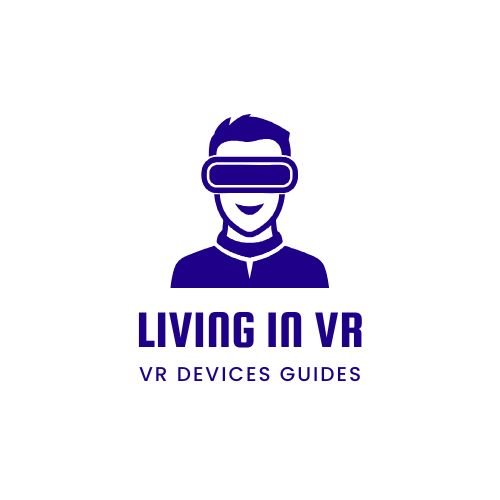
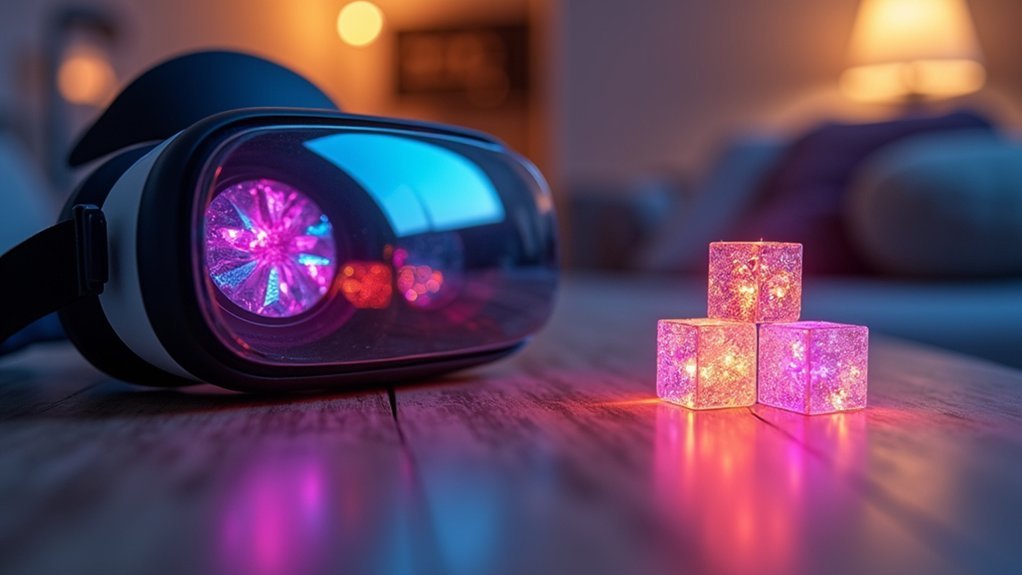


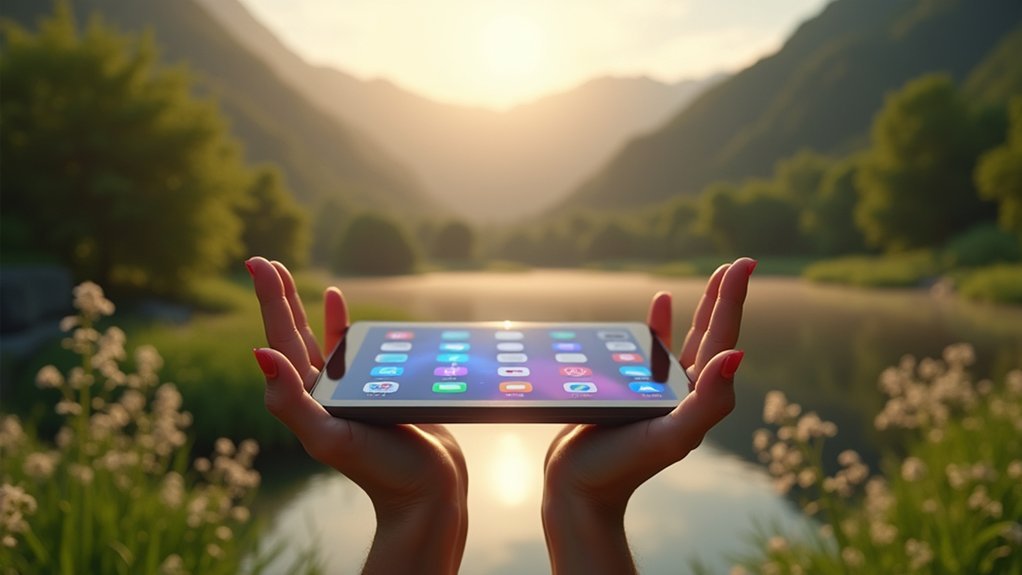
Leave a Reply